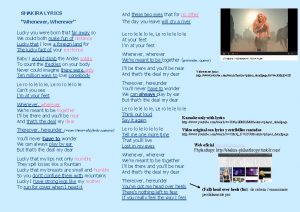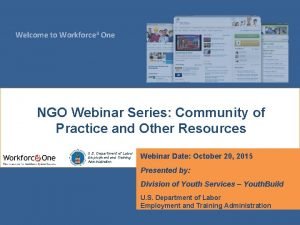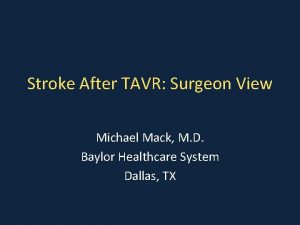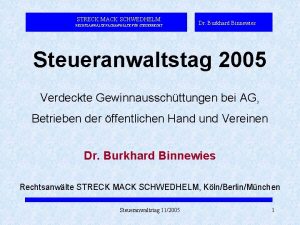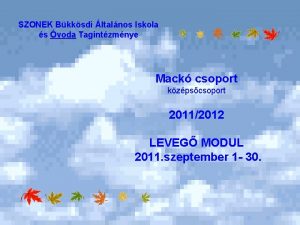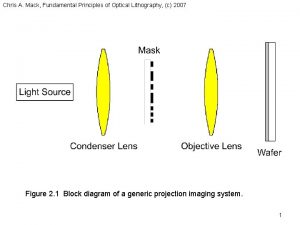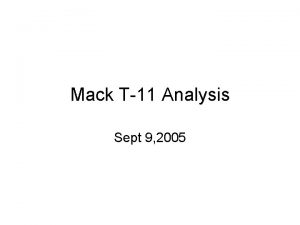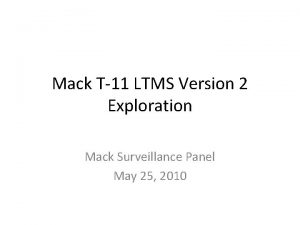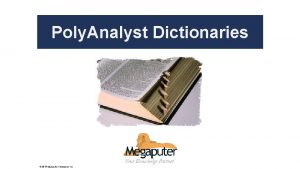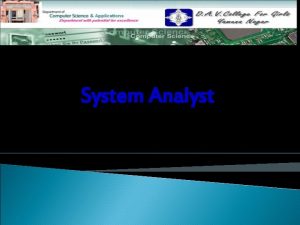Shakira N Mack Senior Program Analyst Office of















- Slides: 15

Shakira N. Mack Senior Program Analyst Office of Hazardous Materials Safety

2

PHMSA 2021: Organizational Structure 3

What Does PHMSA Do? • REGULATIONS AND STANDARDS – Regulates the movement of energy products and hazardous materials by all transportation modes, including pipelines • DATA AND RISK ANALYSIS – Analyzes safety performance, and is continuously improving its data quality and analytic capabilities to identify, assess and manage safety risks • RESEARCH AND DEVELOPMENT – Conducts research and development to improve standards for pipeline safety and hazardous materials transportation 4

What Does PHMSA Do? • TRAINING – Develops publications and curriculum, and provides in-person training opportunities for hazardous materials professionals and emergency responders. – PHMSA’s training and qualification center provides pipeline safety and inspection training for federal and state pipeline inspectors. • GRANTS – Pipeline safety grants support pipeline safety inspection, enforcement and outreach programs – Hazardous materials safety grants provides more than $26 million annually to states, territories, tribes and nonprofit organizations for hazardous materials safety planning and training activities. 5

What Does PHMSA Do? • ADVISORY BULLETINS AND GUIDANCE – PHMSA issues safety advisory notices and bulletins to address emerging risks and share lessons learned from inspections and investigations • INSPECTION AND ENFORCEMENT – PHMSA inspects pipeline facilities, and entities that offer hazardous materials for transportation, including manufacturers and shippers. • ACCIDENT INVESTIGATION – Investigates pipelines failures and other incidents involving hazardous materials 6

Our National Presence 7

Key Issues • • • PIPES Act Implementation Hazardous Liquid pipelines Gathering and Transmission pipelines Valves and Rupture Detection Operator Qualification, Incident Notification Natural Gas Storage FAST Act Implementation Oil Spill Response and Information Sharing Crude Oil Study Safety of Lithium Batteries 8

PHMSA Grants Grant Name Overview Eligibility Award Information Approximately $20 M Hazardous Materials Funding to communities for distributed by formula to Tribes, States and Emergency States and Territories; hazmat emergency planning and Preparedness (HMEP) Territories Approximately $700 K training activities Grants available for Tribes Hazardous Materials Instructor Training (HMIT) Grants Funding for training instructors to Nonprofit train hazmat employees organizations Up to $4 M Community Safety Grants Funding for national outreach and training programs to assist communities in preparing for and Nonprofit responding to accidents and organizations incidents involving the transportation of hazmat Up to $1 M 9

PHMSA Grants Grant Name Overview Eligibility Funding to train emergency responders to effectively respond Assistance to Locals for to incidents that involve Nonprofit Emergency Response shipments of crude oil, ethanol, organizations Training (ALERT) Grants and other flammable liquids by rail. Technical Assistance Grants (TAG) Provides funding to communities for technical assistance (engineering or other scientific) and analyses of local pipeline safety issues Award Information Funded by prior year recoveries Grant may not exceed Local $100, 000 for a single communities, recipient and the funds Tribal entities, and authorized for these Nonprofit grants organizations 10

Examples of Eligible Tribal Activities Funded by PHMSA Grants DOT HAZWASTE regulations training Incident Command training Develop and Update Emergency Plans Table top exercises Hazmat Awareness and Operational Training Commodity Flow Studies Improvement of local pipeline emergency response capabilities Improvement of safe digging or damage prevention programs Development of pipeline safety information resources Implementation of local land use practices that enhance pipeline safety Community and pipeline awareness campaigns 11

Safety Resources • Emergency Response Guidebook: Provides first responders with a go-to reference to help deal with hazardous materials accidents during the critical first 30 minutes. DOT’s goal is to place an ERG in every emergency service vehicle nationwide. • Training: PHMSA supports several types training and technical assistance seminars and workshops enhance regulations compliance, inspection techniques, enforcement uniformity, and emergency preparedness of the thousands of safety professionals shipping, carrying or enforcing compliance for the movement of hazardous materials across the country. • Pipelines and Informed Planning Alliance: Offers local governments, community developers, and pipeline operators a variety of recommendations to improve safety when making land-use decisions near or adjacent to existing transmission pipelines. • Outreach Teams: Hazardous Materials Safety Assistance Team and Community Assistance and Technical Services Managers serve as PHMSA’s designated representatives before a wide variety of stakeholders to provide consultation on new and amended regulatory requirements and conduct training or other public awareness activities. 12

Safety Resources • National Pipeline Mapping System: A geographic information system that contains the locations and attributes of hazardous liquid and natural gas transmission pipelines, liquefied natural gas facilities, and breakout tanks. The NPMS is a valuable tool for planning community growth, emergency response, and pipeline awareness. 811 -Call Before You Dig: Working with the Common Ground Alliance, PHMSA promotes the leading way to prevent damage to pipelines by calling 811 prior to conducting any underground excavation activity. Nearly one-third of all major pipeline accidents are caused by excavation damage and not calling state One-Call centers in advance. • • Hazardous Materials Information Center: Provides help on the use of Hazardous Materials Regulations. Center representatives answer questions regarding regulatory interpretations, accepts reports of hazardous materials violations, or provide other information specific to complying with regulatory requirements. • Safe Travel Website: Increases hazardous materials and battery safety public awareness. Printed guides explain safe travel with consumer-use hazardous materials, and provide a handy list of safety tips to minimize the risk of fires. 13

Contact Us • Hazardous Materials Safety Contacts: Contact the Hazardous Materials Information Center at 1 -800 -HMR 4922 (1 -800 -467 -4922) or 202 -366 -4488 for Washington DC residents Monday through Friday from 9: 00 am to 5: 00 pm (EST). More Hazmat Contacts. • Pipeline Safety Contacts: Contact the Pipeline Safety Information Center at 202 -366 -4595 and Fax: 202 -493 -2311. More Pipeline Contacts. • Enforcement Feedback: Ask questions or submit complaints to Hazardous Materials Enforcement. • Training: Training is available through each PHMSA Region and the Training Center. You can also read more about Training Resources. 14

15

